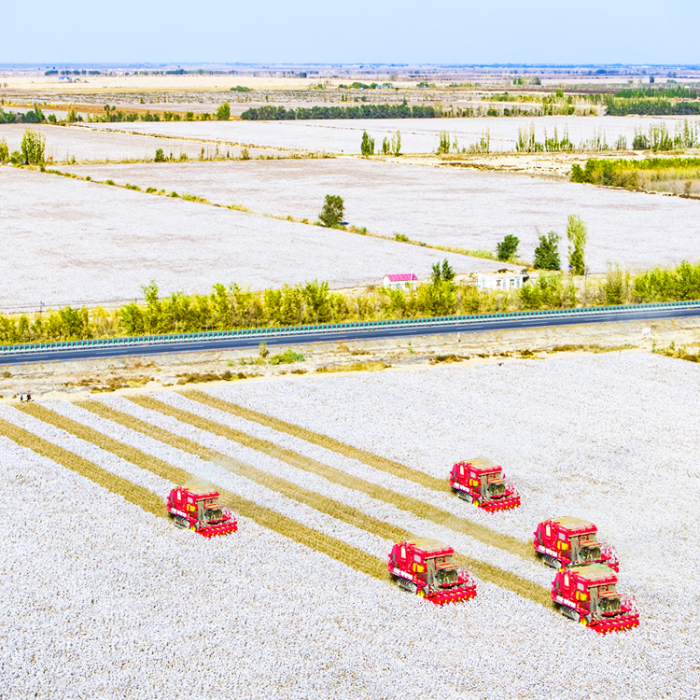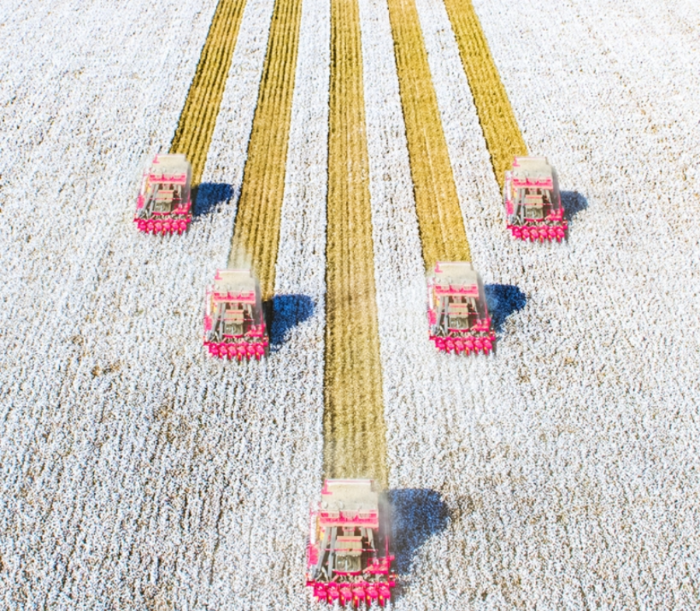Machines help reap bumper cotton harvest in Xinjiang

On an October day, a giant tank-like cotton stripper roars its way through a vast expanse of snow-white cotton fields, leaving behind a long straight swath. Like laying eggs, the big machine releases a tremendous packed roll of cotton around every 15 minutes.
This is a glance of the busy cotton-picking season in northwest China’s Xinjiang. Running from late September to early November, the month-long cotton-picking season is seeing 2.41 million hectares of cotton fields across Xinjiang harvested predominantly by machines.
“A cotton stripper can do the work previously done by a big team of farmers,” said Zhao Yue, a cotton-harvesting machine mechanic hailing from Shaya County in Xinjiang’s Aksu Prefecture.
Zhao remembers the spectacle where hundreds of cotton-picking workers flocked into his hometown by train more than a decade ago. Back then, his family grew around 13 hectares of cotton. “We had to hire at least 20 cotton-picking workers and could barely finish the harvest until late the year,” Zhao recalled. “With the machine, the harvest can be done in a day.”
For the 2023 harvest season, around 6,900 cotton strippers have been put into operation in Xinjiang. More than 85 percent of cotton grown in the region were picked by machines in recent years, official data showed.
Boasting longer hours of sunshine and dry climate, Xinjiang is an ideal place for growing cotton, making it a major cotton-producing region in China. In 2022, Xinjiang produced 90 percent of total cotton harvested across China.
In the late 2000s and early 2010s, cottons in Xinjiang were mainly harvested manually. To solve seasonal shortage of labor, local cotton farmers recruited cotton-picking workers from places outside Xinjiang. Those workers mainly came from Henan in central China, Sichuan in southwest China, as well as Xinjiang’s neighboring Gansu and Ningxia. All of these provincial-level regions had abundant surplus agricultural workers.
Taking the year 2008 as an example. Xinjiang Production and Construction Corps, which usually grows 1 million hectares of cotton every year, recruited 686,000 cotton-picking workers, merely one third of whom were Xinjiang locals.
Against the backdrop of technology development and national support for the application of machines in farming, Xinjiang had long begun promoting the use of cotton harvesting machines. In 2015, the number of large cotton strippers used in the Xinjiang Production and Construction Corps increased to 1,800 from 420 in 2008. In that year’s cotton-picking season, only 142,900 workers were employed to strip cotton, down 78 percent from 2008.
Today, over 90 percent of cotton grown in Xinjiang Production and Construction Corps are harvested by machines. “We can no longer see the seasonal influx of cotton-picking workers into Xinjiang,” Zhao Yue said.

Behind the widespread use of machines in cotton harvesting is the rise of domestic cotton harvester makers in recent years despite China being a late comer in developing and manufacturing cotton-harvesting machines. In 2022, the ownership of domestically-produced cotton harvesters accounted for 51 percent of total cotton-picking machines used across China, outnumbering that of foreign brands for the first time.
China recently exported its first batch of domestically-made cotton-picking machines. In early October, 18 out of the 54 Chinese cotton harvesters ordered by Uzbekistan were delivered and the remaining are expected to be shipped to the Central Asian country by the end of the year.
As joyous as record-breaking cotton stripper exporter, cotton farmers in Xinjiang are expected to reap more than 5 million tonnes of cottons in the ongoing harvest season.
Mixed with the joy of a bumper crop of cotton is some farmers’ bewilderment. They don’t understand why the United States would impose sanctions on Xinjiang’s textile businesses.
“Cotton growing is a main source of income for us farmers. Destroying cotton industry is destroying our life,” said Abdukeyim Rehman, a cotton farmer from Kashgar Prefecture.
Author: Hou Weili
